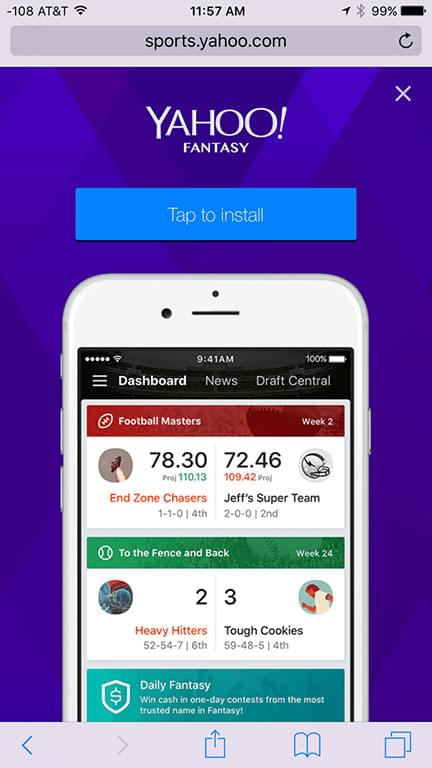Google’s Interstitial Ad Penalty and Its Effect on Mobile Marketers

Key Takeaways
- Beginning January 10, 2017, Google will impose a “pop-up penalty” targeting interstitial ads that cover most or all of a mobile screen, potentially lowering the search ranking of websites displaying such ads. This shift is significant as mobile use accounts for roughly 56% of consumer traffic to top U.S. websites.
- Google’s move to penalize interstitial ads is seen as an opportunity for marketers to enhance mobile user experience. Strategies include developing relevant content that guides audiences through the buying process, ensuring a user-friendly mobile experience with easy navigation and readable text, and updating to the latest Mobile Ads SDK.
- Certain interstitial ads, such as those used for age verification, cookie usage, or paywall logins, will not be penalized by Google. Similarly, mobile banners that are easy to dismiss and don’t take up a large amount of screen space will not incur a penalty.
 Last year, Google put digital marketers on notice that a deep freeze was coming for interstitial ads. Now, the search giant has officially put them out in the cold, a move that will open opportunities for marketers willing to create a better mobile experience for consumers.
Last year, Google put digital marketers on notice that a deep freeze was coming for interstitial ads. Now, the search giant has officially put them out in the cold, a move that will open opportunities for marketers willing to create a better mobile experience for consumers.
Starting January 10, 2017, Google will institute what some observers are calling a “pop-up penalty,” targeting ads that hide or gray-out most or all of a mobile screen. Websites displaying the intrusive advertisements on mobile devices may not rank as highly in search results. It’s a change that will leave a significant footprint; mobile use drives about 56 percent of consumer traffic to top U.S. websites, according to SimilarWeb’s State of Mobile Web in the U.S. 2015 report.
The move isn’t exactly a surprise; in 2015, the search engine giant announced it would penalize websites that displayed interstitial ads prompting users to download an app. Soon after, Apple gave Safari users the ability to install ad blocker apps that would stop interstitials on iPhones and iPads.
It’s important to note that Google will penalize a website in mobile search results only, which seems appropriate given the challenge of navigating the intrusive ads on screens as small as 4.5 inches versus ads viewed on a laptop or desktop. What’s more, interstitial advertising remains one of many signals the search engine uses to assess ranking.
However, don’t expect these mobile pop-ups to disappear completely. If you’re a company using them for age verification, cookie usage, or paywall logins, Google won’t ding you in search results. It also won’t impose a penalty if your business displays mobile banners that are easy to dismiss and don’t take up a large amount of screen space.
Ditching the Frustration Factor
Is everybody happy about the crackdown on these often-frustrating ads? No. Some view Google’s actions over the last year, particularly the decision to penalize app interstitials, as indication it’s creating a monopoly on search.
Yet it seems clear that intrusive interstitials degrade the user experience. For example, Google itself found that 69 percent of users who were shown an interstitial ad for a Google+ app download abandoned the visit completely.
Likewise, outside research suggests the ineffectiveness of this type of ad. Using tools like eye tracking and wireless EEG, researchers found that people looked at mobile banner ads for 200 milliseconds and interstitial ads for 800 milliseconds.
Does that suggest users are more drawn to interstitial ads? Not necessarily. The mobile marketing research, conducted by Spark Experience and WPP agency Light Reaction, discovered that while people viewed interstitials for a slightly longer period of time, most of that was spent looking for the teeny-tiny “X” to close the ad.
Creating Opportunities in a Post-Interstitial World
Anyone who has struggled to find that elusive close button on a mobile ad knows firsthand that Google’s penalty will make mobile search less frustrating. But it will open opportunities for marketers as well. If you’re using large interstitials and pop-ups in your digital advertising efforts, this is the perfect time to reassess and refine your mobile strategy to maximize user experience. Here are two ways to build a better experience in a post-interstitial world:
Develop a content marketing strategy
The consistent creation and distribution of relevant content attracts users without beating them with a hard-sell stick. Use content—including blog posts, round-ups, guides, videos, infographics, and more—to educate audiences and guide them through the buying process.
Don’t fear long-form content, either, even if your audience is primarily using mobile. Pew Research Center found that long-form content, such as articles of 1,000 words or more, attracts small-screen users at about the same rate as its shorter counterpart. Consumers also tend to engage with long-form articles for more than twice as long as short pieces.
Whether your target audience prefers short videos or long-form articles, make sure the content provides value to the user so it retains their attention and activates engagement.
Ensure an overall friendly mobile experience
Mobile friendliness is no longer a web design afterthought; it’s a best practice. Keep eyeballs on the website by designing a hassle-free experience for users, whether they’re your consumers, clients, employees, business partners, or investors.
- Make text on mobile devices readable without the need to pinch-zoom.
- Keep navigation easy and menus simple.
- Incorporate fluid layouts to accommodate screens of various sizes.
- Create simplified forms using a minimal number of fields.
Update to the latest Mobile Ads SDK
One of the best ways app developers can avoid the pitfalls associated with inappropriate ad types is to integrate the latest software development kits (SDKs) into their apps. Google offers its SDKs for iOS and Android for free. Although these still allow interstitials to be used, they offer guidelines that can help app developers determine whether their content qualifies for an interstitial (in the case of age verification, for example) and whether they will present a poor user experience if they are installed.
References and Further Reading:
Winter is coming for the digital marketing industry:
http://www.business.com/online-marketing/winter-is-coming-for-the-digital-advertising-industry/
Google: Helping users easily access content on mobile:
https://webmasters.googleblog.com/2016/08/helping-users-easily-access-content-on.html
Mobile Devices Now Driving 56 Percent of Traffic to Top Sites:
http://marketingland.com/mobile-top-sites-165725
Google: Data Show Users Hate App-Promotion Interstitials:
http://marketingland.com/google-data-show-users-hate-app-promotion-interstitials-136339
Mobile Ad Study Finds Interstitials Only Slightly Better Than Banners for Being Seen:
http://www.adweek.com/news/technology/mobile-ad-study-finds-interstitials-only-slightly-better-banners-being-seen-171980
Long Form Reading Shows Signs of Life in Our Mobile News World:
http://www.journalism.org/2016/05/05/long-form-reading-shows-signs-of-life-in-our-mobile-news-world/
Google: Interstitial Ad Guidance:
https://support.google.com/admob/answer/6066980?hl=en-GB
Frequently Asked Questions (FAQs) about Google’s Interstitial Ad Penalty
What exactly is Google’s interstitial ad penalty?
Google’s interstitial ad penalty is a measure taken by Google to penalize websites that use intrusive interstitial ads, particularly on mobile platforms. These are ads that cover the main content of a page, making it difficult for users to access the information they need. Google’s aim is to improve the user experience on mobile devices, and this penalty is a part of that effort. Websites that use these intrusive ads may see a drop in their search rankings.
How does Google define an intrusive interstitial ad?
Google defines intrusive interstitial ads as those that significantly obstruct a user’s ability to access the content they’re looking for. This could include pop-up ads that cover the main content, standalone interstitials that users have to dismiss before accessing content, or layouts where the above-the-fold portion of the page appears similar to a standalone interstitial but the original content is inlined underneath.
How can I avoid Google’s interstitial ad penalty?
To avoid Google’s interstitial ad penalty, it’s important to ensure that your ads do not obstruct the main content of your page. This could mean using smaller banner ads instead of full-screen interstitials, or ensuring that interstitial ads can be easily dismissed. It’s also important to consider the timing of your ads – for example, showing an interstitial ad upon arrival at your page could be seen as intrusive.
Are all interstitial ads penalized by Google?
No, not all interstitial ads are penalized by Google. The penalty is specifically for intrusive interstitial ads that obstruct the main content of a page. There are certain exceptions, such as interstitials that are legally required (like cookie usage or age verification), login dialogs on sites where content is not publicly indexable, or banners that use a reasonable amount of screen space and are easily dismissible.
How does the interstitial ad penalty affect mobile marketers?
The interstitial ad penalty can significantly affect mobile marketers, as it can lead to a drop in search rankings for websites that use intrusive interstitial ads. This can result in decreased visibility and potentially lower traffic and conversions. Therefore, it’s important for mobile marketers to consider their ad strategies carefully and ensure they’re not negatively impacting the user experience.
How can I check if my website is affected by the interstitial ad penalty?
You can check if your website is affected by the interstitial ad penalty by using Google’s Search Console. This tool can provide insights into how Google views your website and can highlight any potential issues, including penalties. It’s also a good idea to regularly monitor your website’s traffic and search rankings, as a sudden drop could indicate a penalty.
Can I recover from an interstitial ad penalty?
Yes, it is possible to recover from an interstitial ad penalty. The first step is to remove or modify the intrusive interstitial ads on your website. Once this is done, you can request a review from Google through the Search Console. It’s important to note that recovery may take some time, as Google needs to recrawl and reindex your website.
What are some alternatives to interstitial ads?
There are several alternatives to interstitial ads that can be less intrusive and more user-friendly. These include banner ads, native ads, and in-feed ads. These types of ads can still be effective for marketing purposes, but they’re less likely to obstruct the main content of a page and negatively impact the user experience.
How does Google’s interstitial ad penalty align with its overall mission?
Google’s interstitial ad penalty aligns with its overall mission to organize the world’s information and make it universally accessible and useful. By penalizing websites that use intrusive interstitial ads, Google is working to ensure that users can easily access the information they’re looking for, without unnecessary obstructions.
How does the interstitial ad penalty impact SEO?
The interstitial ad penalty can have a significant impact on SEO, as it can lead to a drop in search rankings for websites that use intrusive interstitial ads. This can result in decreased visibility in search results, potentially leading to lower traffic and conversions. Therefore, it’s important to consider the user experience when developing an SEO strategy, and to avoid using intrusive interstitial ads.
Mike Canarelli is CEO and Co-Founder of Web Talent Marketing in Lancaster, PA. His Internet marketing agency specializes in Content Marketing and Digital PR, Search Engine Optimization, Paid Search Management, Social Media and Website Design and Development.




